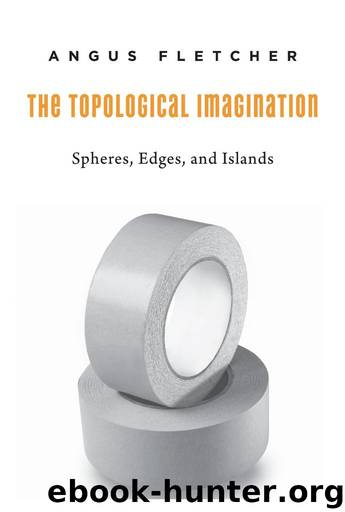The Topological Imagination by Angus Fletcher

Author:Angus Fletcher [Fletcher, Angus]
Language: eng
Format: epub
ISBN: 9780674504561
Publisher: Harvard University Press
Published: 2016-04-03T23:00:00+00:00
Incisive Terms
When it comes to the language of incisive distinctions and divisions our lexicon is almost too rich. “Cut” is what William Empson called a “complex word.” We speak of distinct or newly found significance as a cutting edge; there are cutting boards and cutting remarks and “the unkindest cut of all”; assassins cut off their victims’ heads; armies are cut off at the bridge; someone does or does not make the cut; being chosen is “making the cut”; there is the cut of a suit or “the cut of his jib” or a clear cut in forestry or just a plain haircut; cutting a deck of cards or cutting a class are not as different as one at first might notice. The list goes on and on. “The unkindest cut of all” is only the beginning. A keen look at the Oxford English Dictionary or the original Roget Thesaurus, with its late nineteenth-century ordering categories (but without definitions), shows that edge-terms are linked to controlled movement, and hence to strength, energy, ridges, shores, boundaries and borders, dimensionality, directions, trends, deviations, flexions, success, sharpness and roughness as its antonym, desire and feeling, nervousness, interjacency, progression as in edging forward, obliquity in beveling, ornamenting objects around their borders, and so on. Lacking a concept of edge, there is no way to think of closures and openings or even blurred thresholds, nor can we map geographic boundaries without such an idea in mind, or without a means of graphing or tracing it as a central component of the original Königsberg insights into positions and sequence.
Once again we launch forth into the sea of paradox and metaphor, since Earth conceived as an ideal sphere has no edges, while its face as an inhabited, constructed, or even wild natural scene consists of nothing but edges. To grasp the meaning of such a paradoxical case is the task of imagination, a topological matter rather than a question of measurement, for as Euler had shown, his new geometry of situs was designed to avoid all measurement, focusing instead on the shapes of things and situations. His new emphasis leads mathematics into judgments of quality, perceptions an artist might instinctively treat, and these perceptions tend to resist logical treatment and aesthetic awareness operating simultaneously. On the other hand mathematicians have frequently insisted on the ideal aesthetic aspect of definitive proofs! Particularly in dealing with the ideal versus actual character of our planet as a sphere, we encounter a strong feel of virtual contradiction, since the surface of our planet is far from ideal perfection and regularity, being too full of massive sudden rises and falls, ocean canyons and terrestrial mountain ranges.
Geological time is slow and terrestrial shifts along fault lines do serve an edge-function, providing a dangerous belief in a stable crust. Topology suggests that the one-dimensionality of the edge permits it to define objects bordering on visions of “place,” which is to say more generally, edge creates a language of place. Within civilizations where society inscribes
Download
This site does not store any files on its server. We only index and link to content provided by other sites. Please contact the content providers to delete copyright contents if any and email us, we'll remove relevant links or contents immediately.
| Algebraic Geometry | Analytic Geometry |
| Differential Geometry | Non-Euclidean Geometries |
| Topology |
Modelling of Convective Heat and Mass Transfer in Rotating Flows by Igor V. Shevchuk(6406)
Weapons of Math Destruction by Cathy O'Neil(6213)
Factfulness: Ten Reasons We're Wrong About the World – and Why Things Are Better Than You Think by Hans Rosling(4712)
A Mind For Numbers: How to Excel at Math and Science (Even If You Flunked Algebra) by Barbara Oakley(3256)
Descartes' Error by Antonio Damasio(3247)
Factfulness_Ten Reasons We're Wrong About the World_and Why Things Are Better Than You Think by Hans Rosling(3216)
TCP IP by Todd Lammle(3154)
Fooled by Randomness: The Hidden Role of Chance in Life and in the Markets by Nassim Nicholas Taleb(3079)
Applied Predictive Modeling by Max Kuhn & Kjell Johnson(3041)
The Tyranny of Metrics by Jerry Z. Muller(3026)
The Book of Numbers by Peter Bentley(2928)
The Great Unknown by Marcus du Sautoy(2661)
Once Upon an Algorithm by Martin Erwig(2620)
Easy Algebra Step-by-Step by Sandra Luna McCune(2603)
Lady Luck by Kristen Ashley(2552)
Police Exams Prep 2018-2019 by Kaplan Test Prep(2516)
Practical Guide To Principal Component Methods in R (Multivariate Analysis Book 2) by Alboukadel Kassambara(2512)
All Things Reconsidered by Bill Thompson III(2369)
Linear Time-Invariant Systems, Behaviors and Modules by Ulrich Oberst & Martin Scheicher & Ingrid Scheicher(2346)
